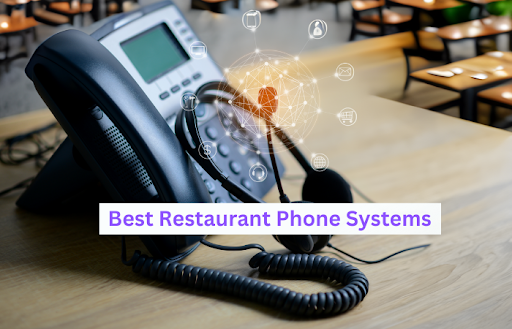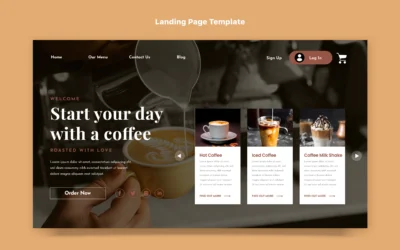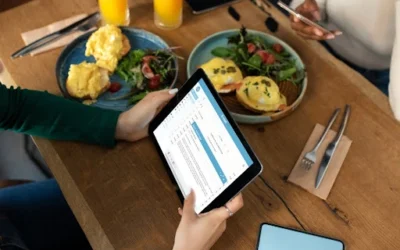Milagro guides on selecting the best phone system for restaurants to improve operations and customer experiences. The right phone system can streamline communication and enhance convenience for both staff and customers. This blog lists the 10 best phone systems designed to meet the unique needs of restaurants. To assist in selecting the right phone system, a study was conducted on popular options, evaluating features, pricing, ease of use, and customer service.
Restaurants require reliable and cost-effective communication systems to ensure smooth operations and customer service. The right phone system is essential for taking reservations and to-go orders without disrupting customer flow. Business phone systems for restaurants should offer worry-free calling and communication features suitable for various settings. To identify the best system, an analysis of popular options was conducted based on features, pricing, ease of use, and customer service.
What is a restaurant phone system?
A restaurant phone system is the communication setup used to manage phone calls in a restaurant. It includes hardware, software, phones, and features that enable efficient communication within the establishment and with customers. The system is essential for managing reservations, taking orders, coordinating deliveries, handling customer inquiries, and facilitating internal staff communication.
The key features of a restaurant phone system typically include:
- Phone Lines: Connecting to multiple lines to manage incoming and outgoing calls simultaneously.
- Extensions: Allowing different restaurant areas or departments to have unique phone numbers or internal extensions.
- Call Management Features: Including call routing, forwarding, voicemail, auto-attendant, call queuing, call deflection, and hold music to ensure effective call handling and customer service.
- Reservation Integration: Some systems integrate with reservation platforms, facilitating seamless management of reservations, table assignments, and customer details.
- Online Ordering Integration: Integration with online ordering systems streamlines the processing of takeout and delivery orders received via phone call.
- Mobile Compatibility: Many modern systems are compatible with mobile devices, enabling staff to handle calls on the go and access system features remotely.
- Reporting and Analytics: Advanced systems provide restaurant analytics, offering insights into call volume, duration, customer wait times, and other performance metrics.
How does a restaurant phone system work?
A restaurant phone system allows communication between the restaurant and its customers and enables internal communication among staff members. Here’s an overview of how a phone system typically works:
- Incoming Calls: When a client dials the restaurant’s phone number, the call is received by the phone system. It may have features like an automated attendant or receptionist who greets the caller with a recorded message and provides options to direct the call to different departments or extensions.
- Call Routing: Depending on the caller’s selection or the system’s configuration, the call is routed to the appropriate department or extension. Different phone extensions can be used to handle specific tasks, such as reservations or takeout/delivery orders.
- Call Handling: The staff member or employee assigned to the specific extension or department answers the call. They can handle customer inquiries, take orders, make reservations, or provide assistance as needed.
- Call Transfers: If a call needs to be transferred to another staff member or department, the phone system allows for seamless call transfers to ensure the customer is connected to the right person without any disruption.
- Voicemail and Messaging: In situations where a call goes unanswered or during off-hours, the phone system may have voicemail capabilities. Customers can leave a message, which will be accessible and retrievable by staff members at a later time. Additionally, certain systems may include functionality for receiving text messages or email notifications.
- Internal Communication: Besides external communication with clients, a restaurant phone system enables staff members to communicate internally. This can be achieved through intercom features, extension-to-extension calling, or group messaging, enabling employees to coordinate effectively and attend to any operational requirements.
- Integration with Other Systems: Many phone systems integrate with reservation platforms, online ordering systems, and other software solutions, enabling a seamless flow of information, such as syncing reservations or automatically populating customer details when taking orders.
Why do restaurants need a phone system?
A restaurant phone system facilitates efficient communication between staff and customers, allowing for prompt handling of inquiries, reservations, and takeout/delivery orders. It also supports reservation management, enabling staff to efficiently handle requests, check availability, and allocate tables. Additionally, the system streamlines order processing for takeout and delivery services, ensuring accuracy and timely service.
What are the benefits of a restaurant phone system?
- Enhance the Customer Experience: A restaurant’s phone system is crucial for providing excellent customer service, as many consumers still prefer using the phone for inquiries and reservations. A reliable multi-line phone system ensures that no calls are missed, and connecting it to a mobile phone allows for constant accessibility. Advanced features such as auto-attendants and callback deflection systems enhance customer experience and build trust by providing efficient and personalized communication.
- Increase Productivity : Restaurant technology, particularly phone systems, can significantly enhance front-of-house team productivity by eliminating distractions such as spam calls. Adding a mobile extension to the system allows managers to take calls on the go, ensuring accessibility and flexibility. Moreover, modern phone systems can streamline order-taking and reservation management, ultimately leading to increased sales.
- Boost Revenue: Increasing revenue and ensuring long-term success for a restaurant involves making it easy for customers to spend money. Implementing or upgrading a restaurant phone system can provide additional channels for customers to place orders and make reservations, ultimately contributing to revenue growth. This approach enhances customer convenience and aligns with the business’s financial goals.
Top 10 restaurant phone systems 2024
Milagro
Milagro Phone System is a custom solution designed to meet your restaurant needs and improve restaurant operations. It includes essential features like auto-attendant, Call Recordings, Ring Groups, call deflection, Voicemail, and more. Milagro aims to simplify things by offering all common features for free as a token of appreciation for their clients.
CallHippo
CallHippo is a cloud-based virtual phone system designed for businesses, including restaurants, to make and receive calls from any location with an internet connection. It offers features to streamline communication and enhance customer service, such as virtual phone numbers from multiple countries and call routing to different staff members or departments based on customer inquiries.
Nextiva
Nextiva offers virtual phone numbers for businesses, including restaurants, allowing dedicated lines for different purposes and locations. The system includes an auto attendant feature for automated menus and greetings, along with detailed analytics to track call metrics for performance analysis and improvements.
3CX
3CX is a diverse and cost-effective business phone system with features such as mobile apps, video conferencing, live chat, and website integration, making it suitable for restaurants of all sizes. It can streamline communication, reduce costs, and enhance customer interactions.
OpenPhone
OpenPhone provides a dedicated business phone number for restaurants, along with mobile and web applications for staff to manage calls. It supports text messaging for customer communication and offers features for setting business hours and after-hours settings. This helps maintain professionalism and efficient communication with customers.
RingCentral
RingCentral is a versatile cloud phone system that enables restaurants to manage calls, appointments, and staff communication. It offers unified voice, video, data, and mobile communication options, facilitating collaboration and customer connections.
Podium Phones
Podium Phones is an advanced phone system designed for small businesses, especially restaurants, to improve customer interactions and revenue. It logs calls and text messages, offers automation features, and provides AI call summaries to enhance customer experience and drive sales. It is recommended for its lead capture and conversion features and comprehensive customer service integration with Podium.
CallRail
CallRail offers advanced call tracking and analytics for restaurants to gain insights into advertising campaigns, personalize strategies, monitor call performance, and improve customer service. It is a valuable tool for optimizing customer outreach and enhancing the overall customer experience.
Ooma
Ooma provides various options to set up a full phone system, catering to different needs and budgets. It even offers a free plan, along with reasonably priced plans with more features. Standard features include voicemail, call forwarding, and call blocking for smooth communication. Users can also customize the system to their needs. Key features include an auto attendant, presence detection, email audio attachments, and video conferencing.
DialerHQ
DialerHQ provides a cloud-based phone system packed with features like call routing, recording, texting, and analytics, all designed for restaurants. It helps make operations smoother and customers happier. It also allows restaurants to easily connect their sales and online ordering systems, improving staff communication. This affordable and user-friendly solution is suitable for both single and multi-location restaurants.
How to choose the right restaurant phone system?
Choosing the right phone system for your restaurant involves careful consideration of specific needs and evaluating various factors. Here’s a comprehensive, step-by-step guide to assist you in making an informed decision:
- Assess Your Requirements: Start by evaluating your restaurant’s communication needs, including call volume, extensions, reservation management, and online ordering integration.
- Identify Key Features: Make a list of essential features such as call routing, voicemail, call recording, and integration with reservation or online ordering platforms.
- Consider Scalability: Choose a phone system that can easily scale up as your restaurant grows, without requiring significant changes or investments in the future.
- Budget Considerations: Determine your budget for the phone system, including installation costs, monthly fees, and additional charges for specific features or add-ons.
- Read Reviews and Seek Recommendations: Research and read reviews from reputable sources, seek feedback from similar businesses, and seek recommendations from industry peers or trusted advisors with experience in restaurant phone systems.
Key Takeaways
Before choosing a phone system for your restaurant, assess your communication needs, identify essential features, consider your budget and ROI, read reviews, seek recommendations, request demos or trials, and evaluate customer support quality.
Frequently Asked Questions (FAQ)
What factors influence the cost of a telephone system?
The cost of a telephone system is influenced by several factors, including the scale of the system, the features required, and the type of technology utilized.
- Scale: The size of your organization and the number of users directly impact the cost. Larger systems with more users generally require more robust infrastructure, resulting in higher costs.
- Features: The features you need, such as voicemail, conferencing, and call forwarding, can significantly affect the overall cost. Advanced features often come with additional expenses.
- Technology: The choice between traditional landline systems and modern Voice over Internet Protocol (VoIP) systems can impact costs. While VoIP is often more cost-effective, it may require initial investment in network infrastructure.
Are there ongoing expenses associated with telephone systems?
Yes, maintaining a telephone system involves ongoing expenses beyond the initial setup.
- Maintenance Costs: Regular maintenance is essential for optimal system performance. This includes software updates, hardware replacements, and general upkeep, incurring recurring costs.
- Service Fees: Many telephone service providers charge monthly fees for their services. This includes line rentals, subscription charges, and any additional services you subscribe to.
- Upgrades: As technology evolves, you may need to upgrade your system to stay current. Budgeting for periodic upgrades is crucial to ensure continued efficiency.
Can I integrate a telephone system with other business tools?
Yes, modern telephone systems often offer integration capabilities to enhance overall business efficiency.
- CRM Integration: Many systems can integrate with Customer Relationship Management (CRM) tools, enabling seamless access to customer information during calls.
- Email and Calendar Integration: Integration with email and calendar systems streamlines communication and scheduling, improving overall productivity.
- Collaboration Tools: Some telephone systems offer integration with collaboration tools, fostering teamwork through features like file sharing and video conferencing.
How much does a telephone system cost?
The cost of a restaurant telephone system can vary based on factors such as the size of the establishment, desired features, and the type of system chosen. Considerations for estimating the cost include the system type (traditional landline, VoIP, or virtual phone system), equipment, installation and setup, monthly service charges, and additional features. VoIP and virtual phone systems generally offer more cost-effective options compared to traditional landline systems, and the inclusion of extra features can impact the overall cost.
What are digital phone systems?
Digital phone systems, also known as digital telephony or digital PBX (Private Branch Exchange) systems, transmit voice signals as digital data over a digital network, such as the Internet or a digital telephone line. They use digital technology to convert analog voice signals into digital packets, enabling efficient transmission and enhanced features.
Key characteristics and features of digital phone systems include the use of VoIP technology, which allows cost-effective and scalable communication solutions, internet-based communication, feature-rich functionality beyond basic call handling, scalability and flexibility to accommodate growing business needs, and cost savings compared to traditional landline systems.





